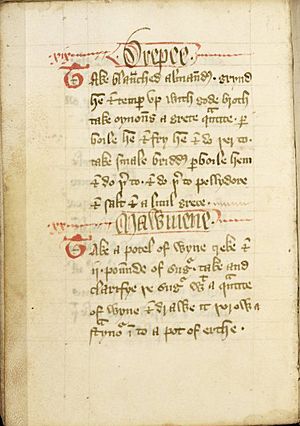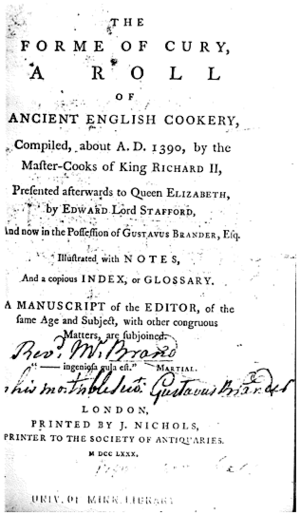The Forme of Cury facts for kids

A page from late 14th-century manuscript in the John Rylands Library, Manchester.
|
|
| Author | The master cooks of King Richard II |
|---|---|
| Translator | Samuel Pegge |
| Country | England |
| Language | Latin |
| Subject | Cookery |
| Publisher | Richard II of England |
|
Publication date
|
c. 1390 |
The Forme of Cury is a huge collection of old English recipes from the 1300s. Its name means "The Method of Cooking." The original book is now lost, but we have nine copies of the text. The most famous copy is a long scroll. It says the recipes were made by the main cooks of King Richard II.
People usually use the name The Forme of Cury to talk about all these recipes together. It is one of the oldest English cookbooks we still have today. It's also the first known English cookbook to mention ingredients like olive oil, gourds, and spices such as mace and cloves.
Contents
About the Cookbook
A man named Samuel Pegge gave the collection its name, The Forme of Cury. He published one of the copies in 1780. This book is one of the most famous cooking guides from the Middle Ages.
The Forme of Cury might have been written to compete with a French cookbook called Le Viandier of Taillevent. That book was made around the same time. This shows that big feasts were a way for kings and lords to show off their power back then.
How the Recipes Were Made
In the beginning of the book, the writers say the recipes teach cooks how to make many different dishes. These include everyday meals and also very fancy ones for big parties. They also mention that the recipes were created with advice from top doctors and thinkers of the time.
The Forme of Cury uses a lot more sugar than another big medieval cookbook, Le Viandier. About 31% of the recipes in The Forme of Cury use sugar. If you include fruit, it goes up to 49%. In Le Viandier, only 6% of recipes use sugar (8% with fruit).
This cookbook is the first English one known to mention certain ingredients. These include cloves, olive oil, mace, and gourds. Many recipes use rare and expensive spices. Some of these are nutmeg, caraway, ginger, pepper, cinnamon, and cardamom.
Spices were used not just for taste, but also for color. The cooks wanted the finished dishes to look rich and beautiful. They often used yellow, red, and green colors. They even used gold and silver on some dishes! Yellow came from saffron or egg yolk. Red came from "sanders" (sandalwood), alkanet, or blood. Green often came from chopped parsley.
The book has recipes for many different animals. These include whale, crane, curlew, heron, seal, and porpoise. There are also about ten vegetable recipes. One is for a vinaigrette salad. This shows that ideas from Portugal and Spain might have influenced the book. French cooks did not use many vegetables back then. There are also several pasta dishes, which shows Italian influence.
Some recipes in The Forme of Cury seem to be inspired by another book, Liber de Coquina. That book had ideas from Arabic cooking. For example, the recipe for mawmenee is like the Arabic mamuniyya, which is a rich semolina pudding. A sweet dish called payn ragoun also shows a link to Sicily. It uses an Arabic way of cooking with soft ball syrup.
A Recipe Example
Here is an example recipe from the book. It is shown in its original old English and then in modern English:
- Sawse madame. Take sawge, persel, ysope and saueray, quinces and peeres, garlek and grapes, and fylle the gees þerwith; and sowe the hole þat no grece come out, and roost hem wel, and kepe the grece þat fallith þerof. Take galytyne and grece and do in a possynet. Whan the gees buth rosted ynouh, take hem of & smyte hem on pecys, and take þat þat is withinne and do it in a possynet and put þerinne wyne, if it be to thyk; do þerto powdour of galyngale, powdour douce, and salt and boyle the sawse, and dresse þe gees in disshes & lay þe sowe onoward.
In modern English, this recipe means:
- Sauce Madame. Take sage, parsley, hyssop and savory, quinces and pears, garlic and grapes. Stuff the geese with them. Sew the hole so no dripping comes out. Roast them well and save the dripping that falls. Take the gelatin and dripping and put them in a posset (a small pot). When the geese are roasted enough, take them out and chop them into pieces. Take what is inside the geese and put it in the pot. Add wine if it is too thick. Add powdered galangal, powder-douce (a sweet spice mix), and salt. Boil the sauce. Arrange the geese on dishes and pour the sauce over them.
Making Old Recipes Today
In 2009, the Café at the Rylands in Manchester cooked some recipes from The Forme of Cury. The John Rylands Library keeps the original manuscript there. They made dishes like Tart in Ymber Day, Compast, Payn Puff, Frumenty, and Gingerbrede. They served them with Piment, which is a spiced wine, to special guests.
See also
 In Spanish: The Forme of Cury para niños
In Spanish: The Forme of Cury para niños


